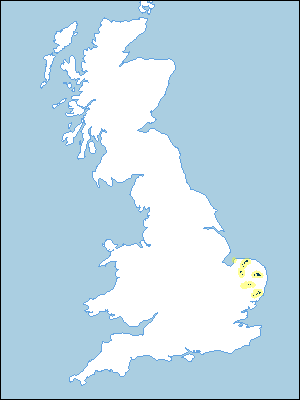
Soil Associations
0572p BURLINGHAM 3
Soil and site characteristics
Deep fine loamy soils with slowly permeable subsoils and slight seasonal waterlogging. Some similar fine or coarse loamy over clayey soils. Some deep well drained coarse loamy over clayey, fine loamy and sandy soils.
Geology
Chalky till and glaciofluvial drift
Cropping and Land Use
Cereals, sugar beet and other arable crops.
Component soil series
| Subgroup | Series name | Percentage | WRB 2006 link |
|---|---|---|---|
| 5.72 | BURLINGHAM | 25% | Endostagnic Luvisols |
| 5.81 | MAXTED | 15% | Ruptic Chromic Luvisols |
| 5.81 | BARROW | 15% | Profundic Chromic Luvisols |
| 5.51 | NEWPORT | 15% | Eutric Lamellic Arenosols |
| 5.72 | WIGHILL | 10% | Endostagnic Luvisols |
| 5.71 | WEASENHAM | 10% | Haplic Luvisols |
| 5.72 | ASHLEY | 5% | Endostagnic Luvisols |
| 5.71 | MELFORD | 5% | Chromic Luvisols |
Covers 291 km2 in England and Wales
Soilscapes Classification
| 8 |
Slightly acid loamy and clayey soils with impeded drainage |
0572p BURLINGHAM 3
Detailed Description
This association occurs mainly on chalky till or Head in Norfolk and Suffolk on crests and gently and moderately sloping valley sides. Some component soils are formed in sandy glaciofluvial drift where this crops out on lower valley slopes, caps the low hills, or forms sandy river terrace deposits that border the larger valleys. The association covers 290 km² - south-east of Norwich, adjacent to the west Norfolk chalklands, along the Little Ouse and Waveney between Coney Weston and Hoxne, and north of Woodbridge. Where the till is relatively impermeable, occasionally waterlogged Burlingham, Ashley, and Honingham series, all stagnogleyic argillic brown earths, occur. Wighill series, which consists of deeper coarse loamy soils is found in Head. Where the till is more permeable, usually where it is thinnest over gravel or chalk, either fine loamy over clayey and fine loamy Melford and Weasenham series, both typical argillic brown earths or reddish, deeply weathered coarse loamy Maxted series and coarse loamy over clayey Barrow series, both typical paleo-argillic brown earths, are found. These well drained soils cover about a third of the land. Newport series, typical brown sands, occurs on river terrace and glaciofluvial sands and gravels. They are well drained and vary in stone content.
In Suffolk, Ashley soils occur more commonly than Burlingham series. Where the drift thins on brows there are Swaffham Prior and Newmarket series on chalk. In Norfolk there is a regular topographic sequence of soils. On the highest ground, Burlingham series and Ashley soils with slowly permeable chalky till subsoils are commonest. On middle slopes there are well drained soils of the Weasenham series, with Maxted soils on lower slopes. Barrow soils occur on the feather edge of the chalky drift. There are Wick soils locally. Newport soils are found in the lowest positions where glaciofluvial sands outcrop on the sides of major valleys and the lower parts of minor valleys. In North Norfolk, in the Stiffkey valley and in west-central Norfolk, in the upper catchments of the Nar and Thet, there are no Newport soils and Maxted and Barrow soils are found on the lowest ground.
Soil Water Regime
The Burlingham, Ashley, Honingham and Wighill series have slowly permeable subsoils and suffer some degree of waterlogging (Wetness Class II or III). Melford, Weasenham, Barrow, Maxted and Newport soils are well drained (Wetness Class I) but gully erosion can occur on Newport soils. The dominant loamy and loamy over clayey soils are slightly or moderately droughty for most arable crops but very droughty for grass. The sandy Newport soils are moderately droughty for arable crops and very droughty for grass.
Cropping and Land Use
The land is used mainly for cereals with sugar beet although harvesting of the latter is often restricted in autumn by adverse soil conditions. Oilseed rape is becoming increasingly important as a break crop. The period available for landwork is often determined by the presence of the heavier soils. There is ample time for autumn cultivations in normal years extending into early December in the drier areas of Norfolk. In north-west Norfolk and on the Cromer Ridge landwork is more restricted especially in wet springs, when cultivations must be carefully timed on the heaviest land. There are more opportunities for spring landwork on the well-drained soils. Newport soils can be worked in winter or spring after one to three rain-free days.
0572p BURLINGHAM 3
Distribution Map
 |
Note that the yellow shading represents a buffer to highlight the location of very small areas of the association.
Keys to component soil series
Eastern Region
 |
All information Copyright, Cranfield University © 2025
Citation: To use information from this web resource in your work, please cite this as follows:
Cranfield University 2025. The Soils Guide. Available: www.landis.org.uk. Cranfield University, UK. Last accessed 25/04/2025
